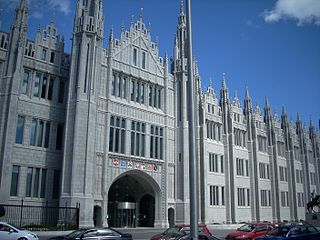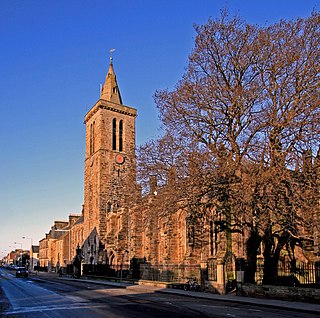
A rector is a senior official in an educational institution, and can refer to an official in either a university or a secondary school. Outside the English-speaking world, the rector is often the most senior official in a university, while in the United States, the equivalent is often referred to as the president, and in the United Kingdom and Commonwealth of Nations, the equivalent is the vice-chancellor. The term and office of a rector can be referred to as a rectorate. The title is used widely in universities in Europe and is very common in Latin American countries. It is also used in Brunei, Macau, Turkey, Russia, Pakistan, the Philippines, Indonesia, Israel and the Middle East. In the ancient universities of Scotland the office is sometimes referred to as Lord Rector, is the third most senior official, and is usually responsible for chairing the University Court.

The University of Dundee is a public research university based in Dundee, Scotland. It was founded as a university college in 1881 with a donation from the prominent Baxter family of textile manufacturers. The institution was, for most of its early existence, a constituent college of the University of St Andrews alongside United College and St Mary's College located in the town of St Andrews itself. Following significant expansion, the University of Dundee gained independent university status by royal charter in 1967 while retaining elements of its ancient heritage and governance structure.

The ancient universities of Scotland are medieval and renaissance universities that continue to exist in the present day. Together, the four universities are the oldest universities in continuous operation in the English-speaking world after the universities of Oxford and Cambridge. The majority of the ancient universities of the British Isles are located within Scotland, and have a number of distinctive features in common, being governed by a series of measures laid down in the Universities (Scotland) Acts 1858–1966. The Universities (Scotland) Act 1966 uses the term 'older universities' to refer to St Andrews, Glasgow, Aberdeen and Edinburgh. The four universities are generally regarded as the country's most selective, eminent and well-ranked universities.

A lord provost is the convenor of the local authority, the civic head and the lord-lieutenant of one of the principal cities of Scotland. The office is similar to that of a lord mayor. Only the cities of Aberdeen, Dundee, Edinburgh, Stirling and Glasgow have a lord provost; other Scottish local authorities have provosts or convenors, which are similar offices to that of a mayor. Perth previously termed its civil leader a "lord provost", but from the Second World War onwards has preferred the simple term Provost of Perth.
The Coalition of Higher Education Students in Scotland (CHESS) was a body representative of students in Scotland, founded in 2001 by the Students' Associations of Aberdeen, Dundee, Edinburgh and St Andrews Universities, and Glasgow University's students' representative council.

Sir James Colquhoun Irvine KBE FRS FRSE FEIS was a British organic chemist and Principal and Vice-Chancellor of the University of St Andrews from 1921 until his death. As a research chemist, Irvine worked on the application of methylation techniques to carbohydrates, and isolated the first methylated sugars, trimethyl and tetramethyl glucose.

There are fifteen universities in Scotland and three other institutions of higher education that have the authority to award academic degrees.
The ancient university governance structure in Scotland is the organisational system imposed by a series of Acts of Parliament called the Universities (Scotland) Acts 1858 to 1966. The Acts applied to what were termed the 'older universities': the University of St Andrews, the University of Glasgow, the University of Aberdeen and the University of Edinburgh. Together these four universities are commonly referred to as the ancient universities of Scotland. Whilst the Acts do not directly apply to the University of Dundee, the same governance structure was ordained for use by that institution in its royal charter.

Undergraduate gowns are a notable feature of academic dress for students at the ancient universities in Scotland.

The East of Scotland Universities Air Squadron, commonly known as ESUAS, is a squadron within the Royal Air Force established in 2003 as an amalgamation of "East Lowlands Universities Air Squadron" (ELUAS) and "Aberdeen, Dundee and St Andrews Universities Air Squadron" (ADStAUAS). It is based at Leuchars Station, in Fife and flies a fleet of six Grob Tutor aircraft. ESUAS is the parent Squadron of No. 12 Air Experience Flight RAF, who share the aircraft.
All types of architectural projects in Scotland are eligible, including new-build, regeneration, restoration, extensions and interiors.

The history of universities in Scotland includes the development of all universities and university colleges in Scotland, between their foundation between the fifteenth century and the present day. Until the fifteenth century, those Scots who wished to attend university had to travel to England, or to the Continent. This situation was transformed by the founding of St John's College, St Andrews in 1418 by Henry Wardlaw, bishop of St. Andrews. St Salvator's College was added to St. Andrews in 1450. The other great bishoprics followed, with the University of Glasgow being founded in 1451 and King's College, Aberdeen in 1495. Initially, these institutions were designed for the training of clerics, but they would increasingly be used by laymen. International contacts helped integrate Scotland into a wider European scholarly world and would be one of the most important ways in which the new ideas of humanism were brought into Scottish intellectual life in the sixteenth century.
The 1882–83 Scottish Districts season is a record of all the rugby union matches for Scotland's district teams.
The 1910–11 Scottish Districts season is a record of all the rugby union matches for Scotland's district teams.










